#much bigger than you’d expect for such a skinny and not particularly tall guy
Note
I was watching one of those tributes to Charlie episodes that John de Christopher put out. Jim Keltner was on it and talked about how Steve was amazed at how thick Charlie's sticks were (I know that sounds like a euphemism) and that he tried to use them for a few songs but he couldn't do it and he mentioned it to Jim. Jim said that when he shook hands with Charlie, Charlie's hands were bigger than Jim's and said that Charlie had "big soft hands" and that George Harrison was the same. Two "small dudes but they had big soft hands." And it made me feel all warm inside, this small elegant gentleman with big soft hands. Awww
For comparison, you can see the size of his hands against Shirley’s shoulder:
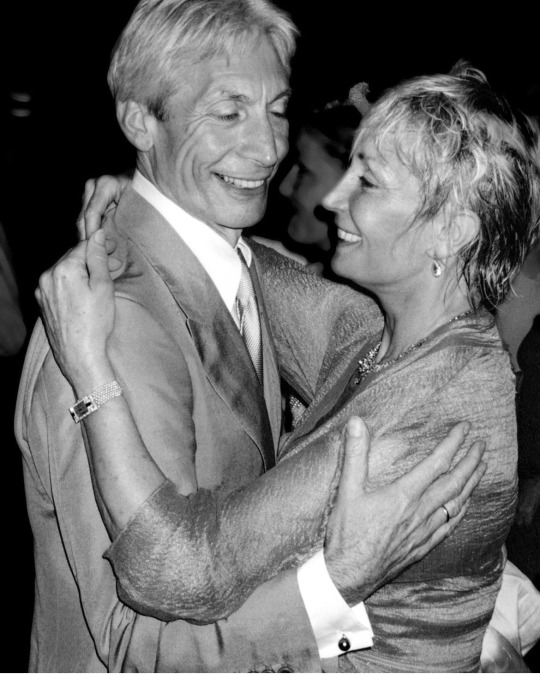
#they are really big#but also beautiful#it’s very old fashioned but they’re what my dad always calls piano player hands#long elegant fingers and a big palm#mick has really large hands as well#much bigger than you’d expect for such a skinny and not particularly tall guy#but they’re like baseball mitts#the rolling stones#charlie watts#old married band#jim keltner#george harrison#video#sound on#ask response#anonymous#doing my best not to think of what the typical implication of men having large hands is
11 notes
·
View notes
Text
Why picking a QB in the 2017 NFL draft is an even bigger gamble than usual

Look at the numbers, and it’s clear these prospects aren’t anywhere near sure things.
The 2016 NFL draft proved two things about quarterbacks:
Quarterbacks are really hard to project.
You can’t make a guy a top prospect simply by drafting him at the top.
Over the last 10 drafts, 43 quarterbacks have been picked in the first two rounds. Of those 43, two were among the NFL’s top 10 in Football Outsiders’ DVOA rating this past season: Matt Ryan and Derek Carr. The other eight were either top picks selected before 2007 (Drew Brees, Ben Roethlisberger, Alex Smith, Aaron Rodgers) or players picked further down (Tom Brady, Brian Hoyer, Kirk Cousins, Dak Prescott).
Fifteen quarterbacks were drafted in 2016. One played really well, and one played at a level slightly worse than the average QB. The others either struggled or never saw the field.
The No. 2 rookie QB on the field was also the second selected: Philadelphia’s Carson Wentz (minus-12.9 percent DVOA). Makes sense, right? But the best rookie QB was the eighth taken; Prescott (plus-31.5 percent DVOA) was selected by the Dallas Cowboys near the end of the fourth round and was probably the NFL’s third-best quarterback.
The worst semi-regular starter in the league was the No. 1 overall pick, Jared Goff.
Gaining a franchise quarterback is regarded as the fastest path to success.
But finding that guy is almost impossible, and so many teams with top draft picks rush the process.
Looking at college numbers before last year’s draft, Goff didn’t stand out from his peers in any major way.
Goff was able to get the ball downfield while taking few sacks. That's good. The main red flag: shouldn't the No. 1 pick check more boxes? He's lanky, his Combine stats and completion rate were okay, he threw a few too many picks, and he offers nothing from a rushing standpoint. Is that a guy you want to trade away your draft for?
One more red flag? From a stat standpoint, it's not immediately evident that Goff's better than the rival from down the road, Stanford’s Kevin Hogan.
Goff was a borderline first-rounder who ended up with Andrew Luck-level expectations. That was unfair to him, and it might have stunted his growth. Goff is entering only his second year, and plenty of QBs have struggled before figuring things out. It would be silly to think of him as a bust already.
At the same time, the No. 1 pick is always going to face a higher bar than Goff was going to be able to clear right away.
Over the last four drafts, teams picked only 2.3 first-round QBs per year; in the 11 drafts before that, that average was 3.1.
You could use this tiny data point to argue teams are starting to show more restraint.
Of course, there’s always a sucker. Or there’s always a desperate team that can’t bear the thought of passing on a potential franchise guy, even if it knows the odds.
Of the eight quarterbacks picked in the first round over the last three years, five have gone in the top three. After the top three, only six quarterbacks have gone in the rest of the first two rounds.
So are there any statistical standouts for 2017, or are NFL execs going to overthink their way into over-drafting QBs again?
We’ll start with the basics. Here are some rate and average stats for what I'll say are the top 22 quarterbacks in this year's class. This includes Dan Kadar's most recent top 15 (signified by the "SBN Rank" below), plus another seven.
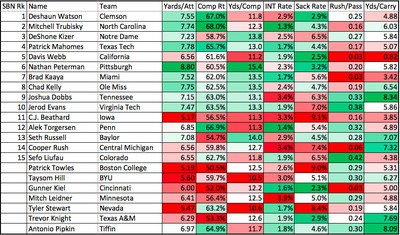
At first glance, there are no standouts, and that could be either good or bad, depending on the patience of your general manager.
Your top two prospects probably deserve to be the top two QBs (but not top two picks).
I think it’s clear why Clemson’s Deshaun Watson and North Carolina’s Mitch Trubisky are regarded as the top QBs, and this data backs up that they should be near the top. Despite each playing against quite a few good defenses, they produced strong stats.
Watson, the preferred choice of most college fans, had a fascinating tenure.
He completed a high percentage, but few went anywhere; he averaged 12.1 yards per completion in 2015 and 11.8 in 2016.
His low sack rates fit the profile of a quick-passing efficiency guy, but he threw more picks than other prospects.
His ability to scramble for 5 yards on third-and-5 was second to none, but he lacked the explosiveness of a true dual-threat guy.
If he were to struggle in the pros, it would be because he might not have a single elite skill.
Trubisky played in the same conference and, as a passer, was equally efficient and slightly more explosive. He threw far fewer picks, too. But he took more sacks and was even less of a run threat.
Odds are, at least one will turn out to be a strong NFL quarterback.
But does Watson or Trubisky really stand out from the rest of the pack that much?
What happens if we combine some of these rate stats with Combine measurables? We get these radar charts.
Clockwise from the top, I've attempted to take you from physical attributes to efficiency to explosiveness/risk/decision-making to mobility. I love radars as easy-to-understand visuals that combine style and quality. A large surface area doesn't automatically make you better than someone with a small surface area, but if someone checks a surprising number of boxes, it makes him worth reassessing.


Physically, both barely meet the bar of your Typical NFL starting quarterback. Watson measured at 6’3, 221 pounds, while Trubisky was 6’2, 222. Trubisky’s hand size is smaller than NFL GMs would like.
The bottom line: Yeah, these are probably your top two guys and could provide decent value as long as they aren’t selected too high.
Let’s check on the latest rumors to make sure no one’s thinking about picking Trubisky at No. 1. Oh. Hey, Cleveland.
If you’ve got one of the top 10 picks, address some other need with your first pick and rest assured: there will be interesting QBs available later.
This year’s crop is full of quarterbacks with undeniable upside and terrifying downside. Maybe that’s the case every year, but among the fivesome of Nathan Peterman, DeShone Kizer, Patrick Mahomes, Chad Kelly, and Joshua Dobbs, you’ve likely got (in some unknown order) three busts, an average QB, and a star. Good luck finding the gem.

Peterman is skinny, and he isn’t much of a runner (from a frequency standpoint, anyway). He also wasn’t particularly interested in the safe throw. But over the second half of the season, there might not have been a more exciting quarterback.
After playing things close to the vest (he was 11 for 15 for 91 yards against Penn State), he let ’er rip. In Peterman's last six games, he completed 85 of 148 (57 percent) for 1,630 yards, 16 touchdowns, and five interceptions. The result: A high pick rate, a low completion rate, three losses ... and a three-game span in which Pitt scored 175 points. He threw five touchdown passes in an upset of Clemson, then completed just nine for 251 and four touchdowns in a 76-61 shootout win over Syracuse.
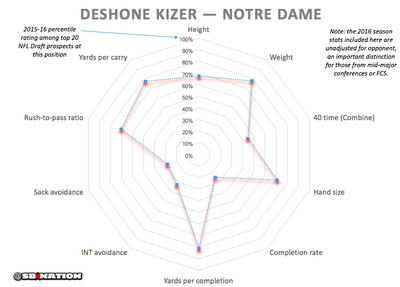
DeShone Kizer is another quarterback who enjoyed swinging for the fences. He didn’t avoid sacks or picks, and his interception rate wasn’t as strong as you’d like. But he’s got a gorgeous arm and big-play capability, via either pass or rush.

Fast-rising Patrick Mahomes II was the only player in the green in every passing category in the chart above. He also has a small stature and small hands. That might scare some teams away, as will the reputation associated with quarterbacks who ran versions of the air raid in college.

Chad Kelly was maybe the most fearless QB in college over the last couple of years. He averaged 13.5 yards per completion in 2015-16, and when he ran, he looked for someone to bowl over. He can throw it as far and as hard as you could possibly want, and his upside was on display in two games against mighty Alabama. In his two starts against the Tide, he completed 44 of 73 (60 percent) for 761 yards, six touchdowns, and no picks, and his Rebels scored 86 points. In that span, the rest of the SEC averaged just 13.3 points per game against Bama.
Oh, and Kelly threw seven interceptions in a three-game span in 2015, and his college passer rating was a below-average 123 during a three-game losing streak in 2016.

Few players manage to go from drastically overrated to drastically underrated during the same season, but that’s what Dobbs pulled off. He fumbles too much (which, combined with his small hands, creates a massive red flag) and makes random mistakes. But when he isn’t glitching, he’s doing incredible things.
Would you prefer someone a little steadier?
If the thought of choosing the wrong high-risk guy is giving you nightmares, you’ve got lower-ceiling, higher-floor options.

Brad Kaaya is tall, skinny, and immobile, but he completed a solid percentage and rarely threw to the wrong team.

Penn’s Alek Torgersen was maybe the best in the draft when it came to making smart passes and scrambling for necessary yardage. He’s also of smaller stature and played in the FCS Ivy League.
Are you just in the mood to say “Screw it!” and roll the dice?

Antonio Pipkin threw for 10,941 total yards and 88 touchdowns as a four-year starter at Division II Tiffin; he also rushed for 2,200 yards in that span ... and averaged 7.3 points per game for Tiffin's basketball team in 2014-15.
Somebody take this guy, please. I want to see what will happen. Entertain me. Be my guinea pig. Yeah, he threw two interceptions in the Senior Bowl. Pick him anyway.
0 notes
Text
Why picking a QB in 2017’s NFL draft is an even bigger gamble than usual

Look at the numbers, and it’s clear these prospects aren’t anywhere near sure things.
The 2016 NFL Draft proved two things about quarterbacks:
Quarterbacks are really hard to project.
You can’t make a guy a top prospect simply by drafting him at the top.
Over the last 10 drafts, 43 quarterbacks have been picked in the first two rounds. Of those 43, two were among the NFL’s top 10 in Football Outsiders’ DVOA rating this past season: Matt Ryan and Derek Carr. The other eight were either top picks selected before 2007 (Drew Brees, Ben Roethlisberger, Alex Smith, Aaron Rodgers) or players picked further down (Tom Brady, Brian Hoyer, Kirk Cousins, Dak Prescott).
Fifteen quarterbacks were drafted in 2016. One played really well, and one played at a level slightly worse than the average QB. The others either struggled or never saw the field.
The No. 2 rookie QB on the field was also the second selected: Philadelphia’s Carson Wentz (minus-12.9 percent DVOA). Makes sense, right? But the best rookie QB was the eighth taken; Prescott (plus-31.5 percent DVOA) was selected by the Dallas Cowboys near the end of the fourth round and was probably the NFL’s third-best quarterback.
The worst semi-regular starter in the league was the No. 1 overall pick, Jared Goff.
Gaining a franchise quarterback is regarded as the fastest path to success.
But finding that guy is almost impossible, and so many teams with top draft picks rush the process.
Looking at college rate stats before last year’s draft, Goff didn’t stand out from his peers in any major way.
Goff was able to get the ball downfield while taking few sacks. That's good. The main red flag: shouldn't the No. 1 pick check more boxes? He's lanky, his Combine stats and completion rate were okay, he threw a few too many picks, and he offers nothing from a rushing standpoint. Is that a guy you want to trade away your draft for?
One more red flag? From a stat standpoint, it's not immediately evident that Goff's better than the rival from down the road, Stanford’s Kevin Hogan.
Goff was a borderline first-rounder who ended up with Andrew Luck-level expectations. That was unfair to him, and it might have stunted his growth. Goff is entering only his second year, and plenty of QBs have struggled before figuring things out. It would be silly to think of him as a bust already.
At the same time, the No. 1 pick is always going to face a higher bar than Goff was going to be able to clear right away.
Over the last four drafts, teams picked only 2.3 first-round QBs per year; in the 11 drafts before that, that average was 3.1.
You could use this tiny data point to argue teams are starting to show more restraint.
Of course, there’s always a sucker. Or there’s always a desperate team that can’t bear the thought of passing on a potential franchise guy, even if it knows the odds.
Of the eight quarterbacks picked in the first round over the last three years, five have gone in the top three. After the top three, only six quarterbacks have gone in the rest of the first two rounds.
So are there any statistical standouts for 2017, or are NFL execs going to overthink their way into over-drafting QBs again?
We’ll start with the basics. Here are some rate and average stats for what I'll say are the top 22 quarterbacks in this year's class. This includes Dan Kadar's most recent top 15 (signified by the "SBN Rank" below), plus another seven.

At first glance, there are no standouts, and that could be either good or bad, depending on the patience of your general manager.
Your top two prospects probably deserve to be the top two QBs (but not top two picks).
I think it’s clear why Clemson’s Deshaun Watson and North Carolina’s Mitch Trubisky are regarded as the top QBs, and this data backs up that they should be near the top. Despite each playing against quite a few good defenses, they produced strong stats.
Watson, the preferred choice of most college fans, had a fascinating tenure.
He completed a high percentage, but few went anywhere; he averaged 12.1 yards per completion in 2015 and 11.8 in 2016.
His low sack rates fit the profile of a quick-passing efficiency guy, but he threw more picks than other prospects.
His ability to scramble for five yards on third-and-5 was second to none, but he lacked the explosiveness of a true dual-threat guy.
If he were to struggle in the pros, it would be because he might not have a single elite skill.
Trubisky played in the same conference and, as a passer, was equally efficient and slightly more explosive. He threw far fewer picks, too. But he took more sacks and was even less of a run threat.
Odds are, at least one will turn out to be a strong NFL quarterback.
But does Watson or Trubisky really stand out from the rest of the pack that much?
What happens if we combine some of these rate stats with Combine measurables? We get these radar charts.
Clockwise from the top, I've attempted to take you from physical attributes to efficiency to explosiveness/risk/decision-making to mobility. I love radars as easy-to-understand visuals that combine style and quality. A large surface area doesn't automatically make you better than someone with a small surface area, but if someone checks a surprising number of boxes, it makes him worth reassessing.


Physically, both barely meet the bar of your Typical NFL Starting Quarterback. Watson measured at 6’3, 221 pounds, while Trubisky was 6’2, 222. Trubisky’s hand size is smaller than NFL GMs would like.
The bottom line: yeah, these are probably your top two guys and could provide decent value as long as they aren’t selected too high.
Let’s check on the latest projections to make sure no one’s thinking about picking Trubisky in the top five. Oh. Hey, Cleveland.
If you’ve got one of the top 10 picks, address some other need with your first pick and rest assured: there will be interesting QBs available later.
This year’s crop is full of quarterbacks with undeniable upside and terrifying downside. Maybe that’s the case every year, but among the fivesome of Nathan Peterman, DeShone Kizer, Pat Mahomes, Chad Kelly, and Joshua Dobbs, you’ve likely got (in some unknown order) three busts, an average QB, and a star. Good luck finding the gem.

Peterman is skinny, and he isn’t much of a runner (from a frequency standpoint, anyway). He also wasn’t particularly interested in the safe throw. But over the second half of the season, there might not have been a more exciting quarterback.
After playing things close to the vest (he was 11-for-15 for 91 yards against Penn State), he let 'er rip. In Peterman's last six games, he completed 85 of 148 (57 percent) for 1,630 yards, 16 touchdowns, and five interceptions. The result: a high pick rate, a low completion rate, three losses ... and a three-game span in which Pitt scored 175 points. He threw five touchdown passes in an upset of Clemson, then completed just nine for 251 and four touchdowns in a 76-61 shootout win over Syracuse.

DeShone Kizer is another quarterback who enjoyed swinging for the fences. He didn’t avoid sacks or picks, and his interception rate wasn’t as strong as you’d like. But he’s got a gorgeous arm and big-play capability, via either pass or rush.

Fast-rising Patrick Mahomes II was the only player in the green in every passing category in the chart above. He also has a small stature and small hands. That might scare some teams away, as will the reputation associated with quarterbacks who ran versions of the air raid in college.
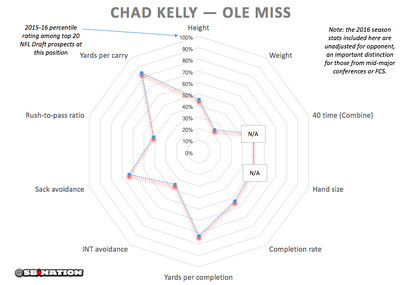
Chad Kelly was maybe the most fearless QB in college over the last couple of years. He averaged 13.5 yards per completion in 2015-16, and when he ran, he looked for someone to bowl over. He can throw it as far and as hard as you could possibly want, and his upside was on display in two games against mighty Alabama. In his two starts against the Tide, he completed 44 of 73 (60 percent) for 761 yards, six touchdowns, and no picks, and his Rebels scored 86 points. In that span, the rest of the SEC averaged just 13.3 points per game against Bama.
Oh, and Kelly threw seven interceptions in a three-game span in 2015, and his college passer rating was a below-average 123 during a three-game losing streak in 2016.

Few players manage to go from drastically overrated to drastically underrated during the same season, but that’s what Dobbs pulled off. He fumbles too much (which, combined with his small hands, creates a massive red flag) and makes random mistakes. But when he isn’t glitching, he’s doing incredible things.
Would you prefer someone a little steadier?
If the thought of choosing the wrong high-risk guy is giving you nightmares, you’ve got lower-ceiling, higher-floor options.

Brad Kaaya is tall, skinny, and immobile, but he completed a solid percentage and rarely threw to the wrong team.
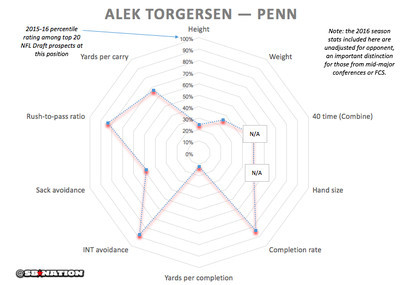
Penn’s Alek Torgersen was maybe the best in the draft when it came to making smart passes and scrambling for necessary yardage. He’s also of smaller stature and played in the FCS Ivy League.
Are you just in the mood to say “Screw it!” and roll the dice?

Antonio Pipkin threw for 10,941 total yards and 88 touchdowns as a four-year starter at Division II Tiffin; he also rushed for 2,200 yards in that span ... and averaged 7.3 points per game for Tiffin's basketball team in 2014-15.
Somebody take this guy, please. I want to see what will happen. Entertain me. Be my guinea pig. Yeah, he threw two interceptions in the Senior Bowl. Pick him anyway.
0 notes